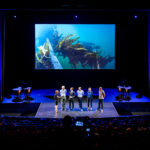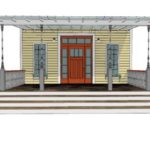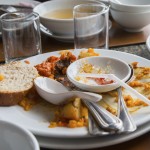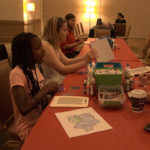Holding a blood drive during a medical meeting sounds like a fairly straightforward CSR initiative — unless you’re AACC (previously known as the American Association for Clinical Chemistry) and your attendees are medical-laboratory professionals. In which case, you do more than collect blood; you process it, much like your attendees do in their work at hospitals and clinics.
Launched during the 2015 AACC Annual Meeting & Clinical Lab Expo, held at Atlanta’s Georgia World Congress Center (GWCC) on July 26–30, AACC’s Universal Sample Bank was designed as an on-site blood drive. Its goal would be to advance cardiac care by collecting healthy attendees’ blood and using it to help establish a 99th-percentile range for a key biomarker called cardiac troponin, used to diagnose acute myocardial infarctions (heart attacks).
The scope of the project included having the blood donations “processed” at the GWCC, just like they would be in a normal laboratory setting, said Gary L. Myers, Ph.D., AACC’s vice president for science and practice affairs. That way, the serum/plasma samples would be prepared and ready to distribute to in-vitro diagnostic companies (IVDs). “It was our first attempt at anything of this order,” Myers said. “It was right up our alley.”
A ‘LOGISTICS PUZZLE’
For Gail E. Mutnik, AACC’s director of meetings and exhibits, the blood blank was a “logistics puzzle” — starting with identifying a room at the GWCC that would be large enough to accommodate the project, and ensuring that human-subject blood collection was allowed in the building. “We had to agree to use the hazardous-waste protocol, and make sure that the center was informed about what we were going to do and how we were going to do it,” Mutnik said. “We also needed to get insurance from our insurance company in order for us to proceed.”
Another key piece was obtaining Institutional Review Board (IRB) approval for human-subject experimentation, which is required for this type of activity. Because donors wouldn’t be given any results from their samples, the sample bank was considered a research project, Myers said. AACC worked with Emory University School of Medicine for the IRB, because not only is Emory located in Atlanta, AACC’s president is an Emory employee. “We started that process probably in February,” Myers said, “and we didn’t get approval until May.”
“While the IRB was going on, we knew that we needed to be planning. We couldn’t just wait until the IRB happened,” Mutnik said. “I worked with [convention-services company] Freeman to lay out a room. We had several iterations of what that room should look like. First, it was six collection stations, then it was nine, then it was 14, and then it was how the equipment in the rooms should be laid out.”
Myers and Mutnik reached out to exhibit vendors who provide equipment or supplies “that would help us in this endeavor — to either donate them to us and/or to have us purchase if we needed something at a discount,” Mutnik said. “We went from one auto-sampling instrument to two instruments, two lab tables to four lab tables, etc. It was an ongoing process. As we talked though the logistics, we realized there were other things that we needed, [such as] we needed tables for people to work that weren’t just tables that the machinery was on.”
Every question seemed to lead to another. “I kept saying, ‘I have a question. It might be stupid, but I have a question,’” Mutnik said. “I was asking about logistics, not science. I was saying, ‘If X happens, how do we get to Y? If Y happens, where do we store Z?’ Do we need shelves, or do we need bookcases? Do we need boxes, or do we need carts? Does every machine need its own plug, or can we get strip plugs? What do we need in terms of air conditioning? Dry ice? Coolers? What do we need to do in terms of delivery, and when are people coming and picking up?”
ROLLING UP THEIR SLEEVES
For the blood-drawing part of the Universal Sample Bank, AACC contracted with Atlanta’s Grady Memorial Hospital for licensed phlebotomists. Grady’s head phlebotomist also provided advice on how to set up the room. Configuring an actual laboratory that was part of the sample bank and yet segregated — “where the blood would be taken after it was collected,” Myers said, “and it would be processed just like it would be if you took it to Quest Diagnostics or LabCorp” — represented the biggest challenge. “We also had to think of HIPAA [Health Insurance Portability and Accountability Act] privacy issues,” Mutnik said. “We couldn’t just collect blood in the open. We had to create individual rooms with a drape for people to go in and have privacy.”
AACC collected blood from 766 donors attending the meeting. “We were able to manage the crowd, but not without difficulty,” Mutnik said. “We had thought that we were fully equipped. We had started the conversation back in the office about how we could process so many samples in so many hours, and we realized pretty quickly that we weren’t going to get through them all. That’s when we asked one of our vendors for a second instrument to help process, and we had two centrifuges instead of one.
“We got a lot of extra phlebotomists to help us with samples. In addition, we had two other staff members who have worked in blood banks before, and they were in the room constantly. That is one of our lessons learned — how much you can really process at one time, and how many people are really needed in the back end. More than we knew. We were learning as we were going.”
The next time AACC conducts a project of this kind, it will allow for more planning time. “If we were doing this again, rather than start five or six months out, we would start out probably a whole year in advance planning this,” Myers said. “That was the feedback we also got from our vendors. They were extremely excited and very helpful, and they all said in the end, if you do this again, we want to be involved, because this was a very interesting project. But we need to plan it a year in advance, so that they could provide us with the best equipment and service.”
The process of thinking through every kind of logistical requirement for the Universal Sample Bank taught Mutnik more about the science side of her organization than she expected. “She actually was able to tell her scientific committee, her organizing committee, all about this,” Myers said, “and they were impressed that she knew so much about how to put a lab together.”
Moreover, the experience honed her skills as a meeting professional. “I think from a logistics point of view, or from a meeting-planning point of view, projects like this really help people in our industry grow and learn,” Mutnik said. “It’s sort of like adding a huge meeting on top of the meeting you’re already doing.”





